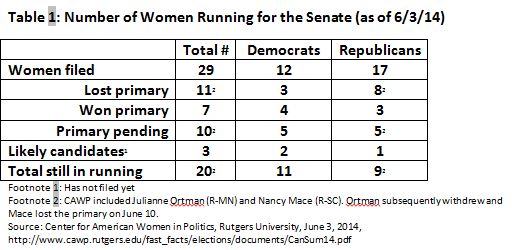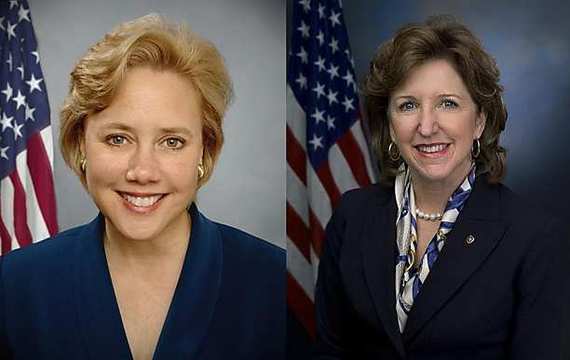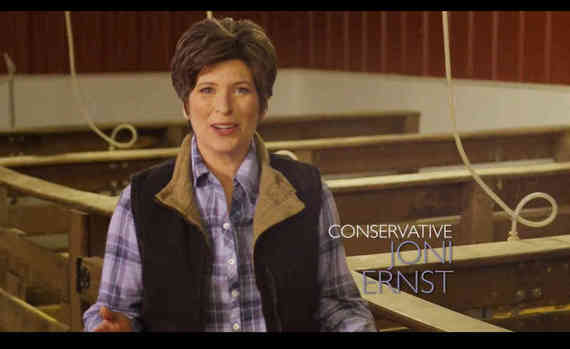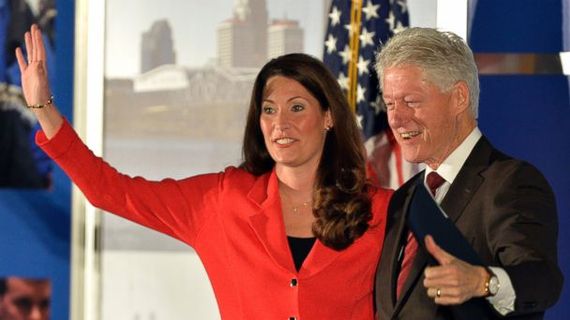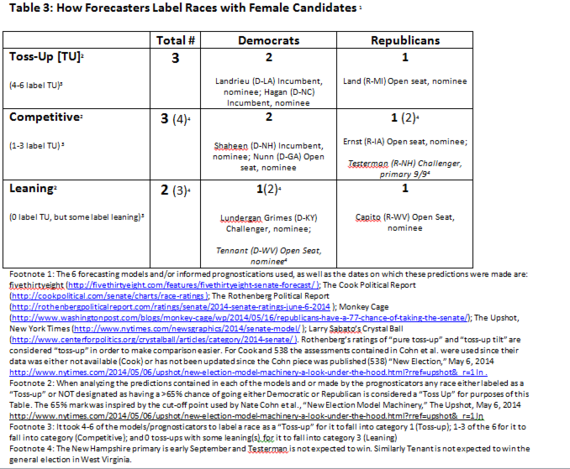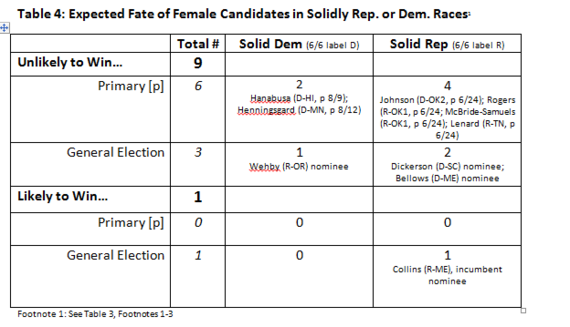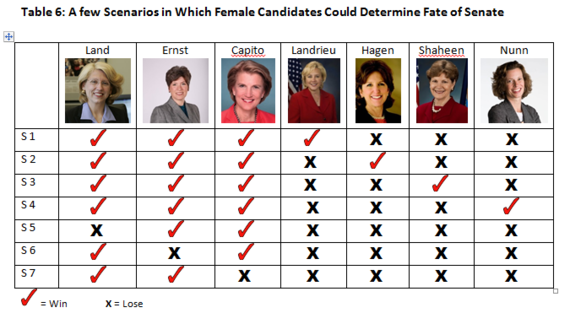According to MSNBC's Joe Scarborough, the race for the Senate may come down to four women: Alison Lundergan Grimes (D-KY), Michelle Nunn (D-GA), Kay Hagan (D-NC), and Mary Landrieu (D-LA). The Weekly Standard's Bill Kristol cites four Republican women who can win in November: Shelley Moore Capito (WV), Monica Wehby (OR), Terri Lynn Land (MI), and Joni Ernst (IA).
But do female candidates really hold the future of the Senate in their hands? Is the partisan makeup of the Senate intimately tied to the fate of female candidates making this truly "the Year of the Woman?"
Commentators first used this label in 1993 when four women were elected to the Senate in a single year. In response. Senator Barbara Mikulski said "calling 1992 the Year of the Woman makes it sound like the Year of the Caribou or the Year of the Asparagus. We're not a fad, a fancy, or a year."
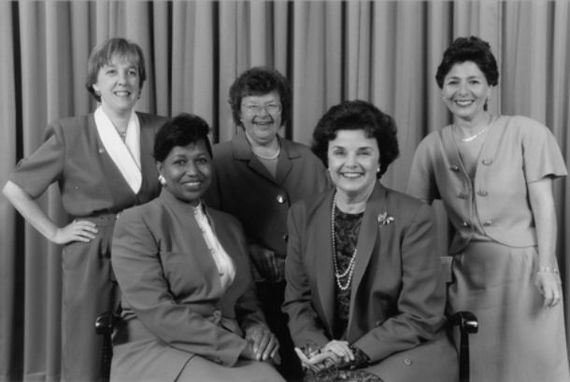
To their credit, neither Scarborough nor Kristol engaged in such hyperbole. And this year it isn't just about the sheer number of female candidates but whether they could play a key role in determining whether the Senate goes Republican or remains Democratic?
According to the Center for American Women and Politics (CAWP) at Rutgers University, 20 women are currently running for the U.S. Senate. This includes 11 Democrats and 9 Republicans.
Of the 34 states with Senate races this year, CAWP estimates a little less than half have potential female candidates including four who are running as incumbents, eight who are running for open seats, and eight who are running as challengers.
One of the best ways to determine whether the fate of the Senate rests in the hands of female candidates is to look at how they figure into six of the most well-known forecast models and how they are handled by informed race prognosticators. Among the models and prognosticators considered: FiveThirtyEight, The Cook Political Report, The Rothenberg Political Report, The Monkey Cage, The Upshot, and Sabato's Crystal Ball.
Of the 20 female candidates, three are running for seats that most prognosticators label toss-ups: Mary Landrieu (D-LA), Kay Hagan (D-NC), and Terri Lynn Land (R-MI). Both Landrieu and Hagan are Democratic incumbents defending their seats, while Land is a Republican running for an open seat.
Four other female candidates are running in races that 1-3 of the 6 forecasters describe as toss-ups: Michelle Nunn (D-GA), Joni Ernst (R-IA), Jeanne Shaheen (D), and Karen Testerman (R-NH). Nunn and Ernst both won their respective primaries and are running for open seats. Shaheen (D) is running unopposed for the Democratic nomination in New Hampshire. While on the Republican side, Testerman faces a number of challengers, including the former Senator from Massachusetts Scott Brown who is currently leading in most polls. Based on the current polling Testerman is unlikely to win the primary on September 9.
Three other candidates are running in states that almost all models suggest are solidly Republican or Democratic but that at least one forecaster suggests may only be leaning in that direction. In short, these are races to watch for an upset. The West Virginia race features two female candidates, Republican Shelly Moore Capito, who is currently leading in the polls and Democrat Natalie Tenant. In Kentucky the well-known Democratic nominee Alison Lundergan-Grimes is facing incumbent Senator/Minority Leader Mitch McConnell (R).
Given that Testerman is not expected to win the Republican primary in New Hampshire and Tenant and Capito are facing each other, there are actually eight races worth watching.
The 10 other female candidates are running in races that prognosticators agree are either solidly Republican or Democratic. These are races that the forecasters suggest one side is almost certain to win -- in short they are unlikely to present any surprises. Moreover, as Table 4 shows, 9 of the candidates are unlikely to win either their primary or general election bids. The only candidate likely to prevail is incumbent Senator Susan Collins (R-Maine).
There are currently
There are a total of 36 seats up this cycle, 21 held by Democrats and 15 held by Republicans.
Based on what the data shows about the current status of female candidates and the makeup of the Senate, Scarborough and Kristol are correct to say there are several scenarios in which female candidates could play a decisive role in the partisan makeup of the Senate. Just looking at the eight key races for instance, if Land, Ernst, and Capito won and three of the following four lost (Landrieu, Hagan, Shaheen, or Nunn), the GOP would have the 6 seats they need to capture the Senate. Similarly, if just two of the following 3 Republicans won (Land, Ernst, and Capito) and all four of the following Democrats lost (Landrieu, Hagan, Shaheen, and Nunn), the GOP would take the Senate.
It is possible to come up with several other scenarios in which these (and other) female candidates could determine the makeup of the Senate. When commentators coined 1992"The Year of the Woman" they did so because an unprecedented number of women were elected to the Senate. In 2001 the nine women serving in the Senate published Nine and Counting, a book which chronicled their stories and struggles.
Now, more than a decade later, 20 women (16 D, 4 R) are serving in the Senate and 29 filed to run. This does not make 2014 a record year in terms of the sheer number of female candidates. According to CAWP 36 female candidates filed to run in both 2010 and 2012. But what does distinguish this year is that perhaps for the first time in American history, female candidates may play a decisive role in determining the fate of the Senate as well as the president's second term prospects. It may not be "the Year of the Woman" but it is a year in which female candidates are positioned to play a vital role in the outcome of the race.


